

This Month's Oddity:
New species of amphibious dinosaur, say experts
IN THE ODDITIES ARCHIVES
Elisa Lam
Secret Room
Animal Thieves
Catfish Falls
Arson Lawyer
Cockroach in Nose
New dinosaur looks like odd mix of duck, crocodile, ostrich, and swan
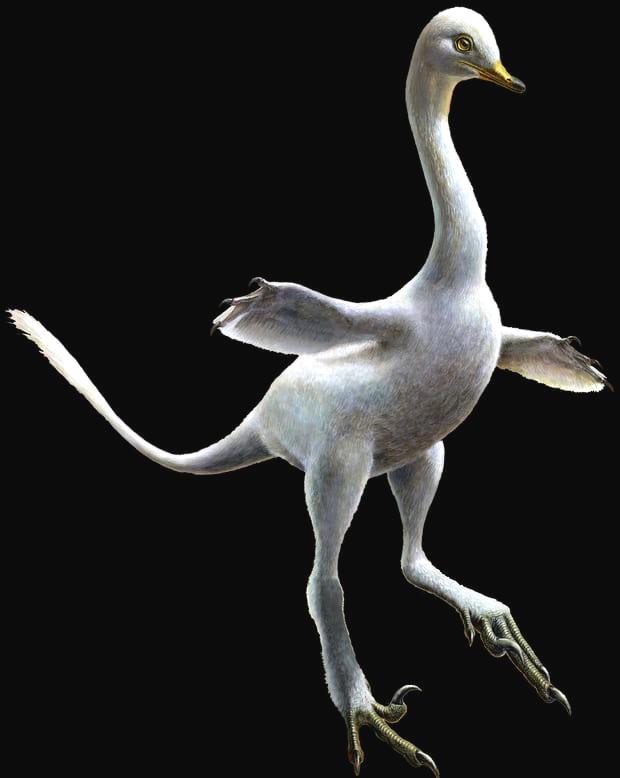
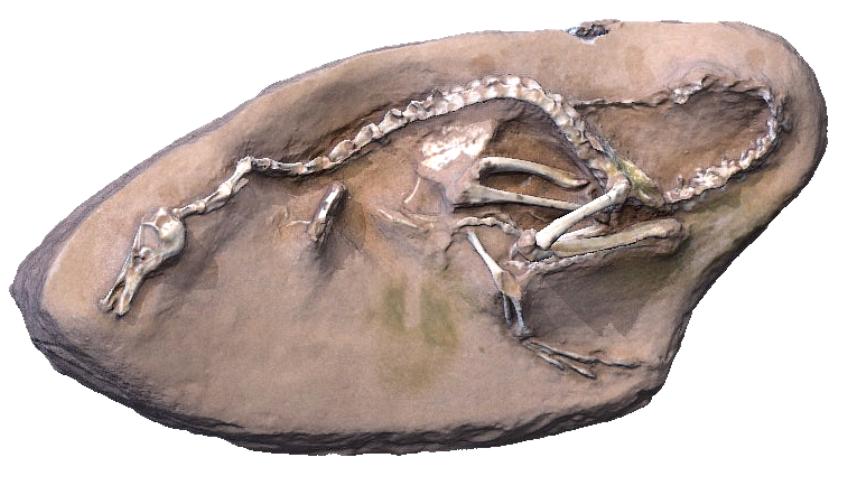
Reconstruction of Halszkaraptor escuilliei. This small dinosaur was a close relative of velociraptor, but in body shape and inferred lifestyle it resembles modern birds such as swans. Photograph: Lukas Panzarin/Andrea Cau
The Guardian, December 6, 2017 -- An unusual set of fossilized remains illegally poached from Mongolia belonged to a new species of dinosaur with the rare trait of living on both land and water, researchers have claimed.
Thought to have lived around 71–75m years ago, the creature boasts a swan-like neck, razor-sharp “killer claws” on its feet, a duck-billed snout and forelimbs with proportions that might have helped it swim.
“What is very special about it is that it looks very weird. It doesn’t look like any other dinosaur that we know so far,” said Vincent Fernandez, a palaeontologist at the European Synchrotron Radiation Facility and a co-author of the research. Fernandez also noted that while the claws are a feature thought to be useful on land, the other features would help with hunting fish.
“When we add up all the [characteristics] it shows that it was an amphibious animal – it was able to run on land, as we imagine dinosaurs running around, and on top of that it was able to go into water,” Fernandez said, adding that the creature’s body was about the size of a mallard duck, but with a long tail and longer legs.
While early members of the group that includes modern birds show signs of a water-based lifestyle, the adaptations are very rare in non-avian dinosaurs. Sauropod footprints, made in lagoons, have been found in Scotland, but only giant meat-eaters known as spinosaurids have previously been heralded as showing skeletal modifications that indicate a truly amphibious lifestyle.
The new fossil is believed to have been unearthed in the Gobi Desert, in a dinosaur-rich area of southern Mongolia known as Ukhaa Tolgod that would once have had ephemeral rivers and even lakes.
But details of the fossil’s provenance remain sketchy, since the specimen has spent years in private collections after it was illegally bundled out of Mongolia. It ended up in the hands of scientists, and is being returned to to its home country thanks to its most recent owner – collector and fossil dealer François Escuillié.
The team of palaeontologists were so surprised by the creature that their first step was to make sure that it wasn’t a chimera made from a mash-up of fossils.
Using a high resolution scanning technique that employs radiation produced by a particle accelerator known as a synchrotron, the team were able to explore the fossil even though it was still partially embedded in rock.
The results, published in the journal Nature, not only showed that the remains were from just one creature, say the authors, but also revealed hidden details.
Among the discoveries, the team note that the very front part of the animal’s snout has more teeth than any other dinosaur.
“The shape [of the animal’s teeth] as well is very unusual, and that was the first evidence of the amphibious lifestyle, because really they look like crocodile teeth, because they are curved backwards” said Fernandez. The authors point out that a long neck is common in modern birds and reptiles that ambush prey in water, and that the curved teeth would help to trap the prey.
In addition, the creature had a neurovascular system in its snout similar to that seen in crocodiles, and a relatively short tail and skeletal features that mean it would have moved on land in a more upright stance than its close relatives – more akin to modern birds.
Named Halszkaraptor escuilliei after the late palaeontologist Halszka Osmolska and the collector Escuillié, the authors say the creature is not only a new species of dinosaur, but opens up a whole new sub-family, encompassing two other previously unearthed and unusual creatures.
Despite its intriguing features, the new creature was not a bird but a primitive member of a group of non-avian theropod dinosaurs known as Dromaeosaurs, which includes velociraptors, says Fernandez.
“It is a stunning fossil,” said Stephen Brusatte, a palaeontologist at the University of Edinburgh who was not involved in the study. But, he said, despite the careful analysis by the authors, he has concerns.
“I just have some nagging doubts about whether the whole thing is one genuine skeleton,” he said, adding that while it is easy to spot a bad fake, modern tampering can be highly sophisticated. “The thing that piques my curiosity is that the body really looks like a dromaeosaur, a raptor dinosaur, and the head really looks like an alvarezsaur – that’s another type of small dinosaur.”
While Brusatte added that it is both possible the fossil is genuine, and that the creature was amphibious, he pointed out that other theropods – and even modern animals like ostriches – had long, slender necks but didn’t hunt in the water. “I don’t see any slam-dunk evidence that this thing was semi-aquatic,” he said. “There is a long way to go to really prove it.”
See the entire article HERE

HOW DOES THE WISHBONE PROVE THAT DINOSAURS EVOLVED INTO BIRDS?
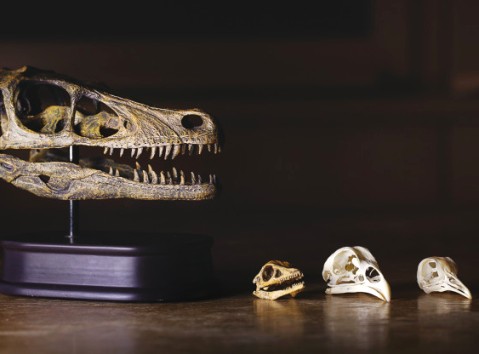
As dinosaurs morphed into birds, they shrank dramatically and adopted a more babylike skull shape. Shown left to right: Velociraptor, a dinosaur of the class that gave rise to birds; Archaeopteryx, often called the first bird; and a modern chicken and pigeon.
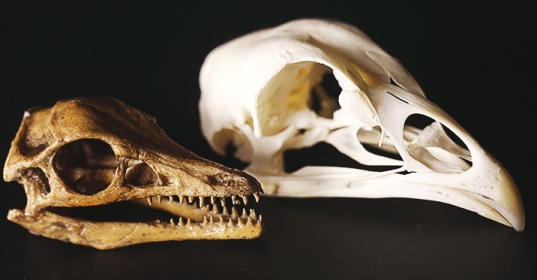
The ancient archaeopteryx (left) has a snout and teeth, like dinosaurs. Modern chickens have large brains and eye cavities in the skull, as well as a long beak.
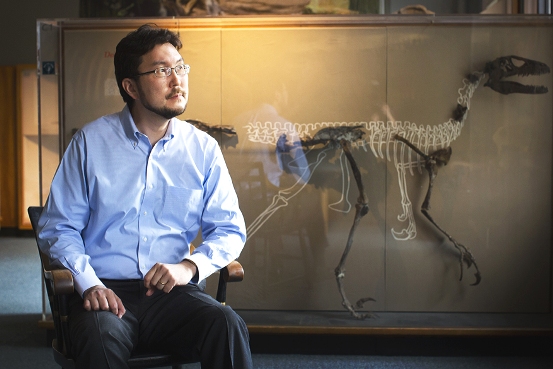
Arkhat Abzhanov, a biologist at Harvard University, with a partial skeleton of a Deinonychus, a birdlike dinosaur that likely had feathers.
Wishbones and Dinosaurs: The anatomical structure we call the wishbone was long thought unique to birds. But fossil discoveries of recent decades have shown that some dinosaurs, including the mighty Tyrannosaurus rex, and the Velociraptors of ”Jurassic Park,” also had wishbones.
“A bird didn’t just evolve from a T. rex overnight, but rather the classic features of birds evolved one by one; first bipedal locomotion, then feathers, then a wishbone, then more complex feathers that look like quill-pen feathers, then wings,” Steven Brusatte said (a paleontologist at the University of Edinburgh in Scotland). “The end result is a relatively seamless transition between dinosaurs and birds, so much so that you can’t just draw an easy line between these two groups.”
Yet once those avian features were in place, birds took off. Brusatte’s study of coelurosaurs found that once archaeopteryx and other ancient birds emerged, they began evolving much more rapidly than other dinosaurs. The hopeful monster theory had it almost exactly backwards: A burst of evolution didn’t produce birds. Rather, birds produced a burst of evolution. “It seems like birds had happened upon a very successful new body plan and new type of ecology — flying at small size — and this led to an evolutionary explosion,” Brusatte said.
See more HERE